Introduction
A bird feeder window A might be the best thing your home is missing. Ever wonder why your yard feels empty even in a bird-rich area? You’re not alone! Many homeowners struggle to attract birds to their outdoor spaces.
And that means less colour, fewer songs, and zero daily nature shows. Yet, a simple installation of a window bird feeder can flip that script overnight. Unlike the traditional yard feeders, window feeders bring them up close and personal.
In this blog, we’ll break it all down:
- What are window bird feeders?
- The different types you can get
- The good and bad, and how to choose the right one
- How to install and maintain them
- Making windows safer for birds
- And even which birds you might spot in your glass
By the end, you’ll know exactly how to turn your empty view into a lively, colourful scene. Let’s dive in!

What is a Window Bird Feeder?
It is a window-mounted bird feeder that you can attach to your windows directly via suction cups, adhesive mounts, or bracket systems. As they are transparent or translucent, you can watch birds feed from just inches away on the other side of your window. Many bird lovers enjoy placing a bird feeder window in their kitchen or home office for a calming view throughout the day.
They come in various styles, from simple seed trays to elaborate tube feeders. We’ll look into more details below. Most of these feeders are designed to hold common bird foods like sunflower seeds, nyjer seeds, or suet. They’re also sturdy and easily removable for cleaning and refilling.
Types of Window Bird Feeders
Different window bird feeders are designed to attract various bird species and accommodate several feeding preferences.
(To add visual appeal to your indoor space near feeders, consider complementing your area with indoor flowers and plants that are bird-friendly.)
Suction Cup Seed Trays

These are shallow plastic or acrylic trays with strong suction cups. You can keep mixed seeds between them and attract ground-feeding birds like sparrows, cardinals, and finches. Their open design allows multiple birds to feed simultaneously and offers easy cleaning access.
Window-Mounted Tube Feeders
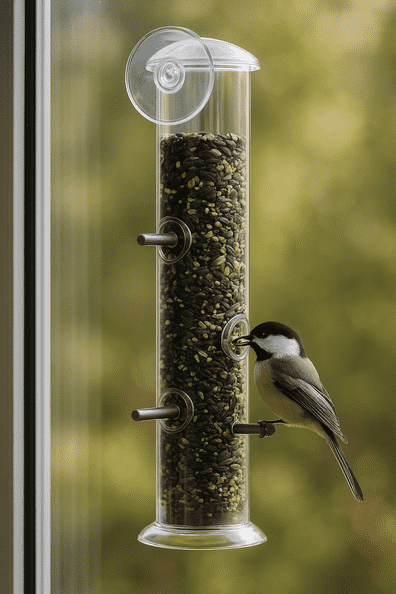
These cylindrical feeders feature multiple feeding ports and perches. Window-mounted versions use bracket systems or large suction cups to secure against glass. You can attract smaller birds like nuthatches, chickadees, and goldfinches.
Suet Feeders
They’re generally meant to keep fat balls or suet cakes. You can attach wire cage feeders to windows via brackets or suction cups. It turns them into a practical bird feeder window setup. Suet feeders will help you feed and attract birds like woodpeckers, nuthatches, and other high-energy birds.
Hopper-Style Window Feeders
They are tiny house feeders featuring slanted roofs and glass or plastic sides that protect seeds from the weather. They hold larger quantities of food and attract a variety of bird sizes, from small finches to larger cardinals and jays.
Nectar/Hummingbird Feeders
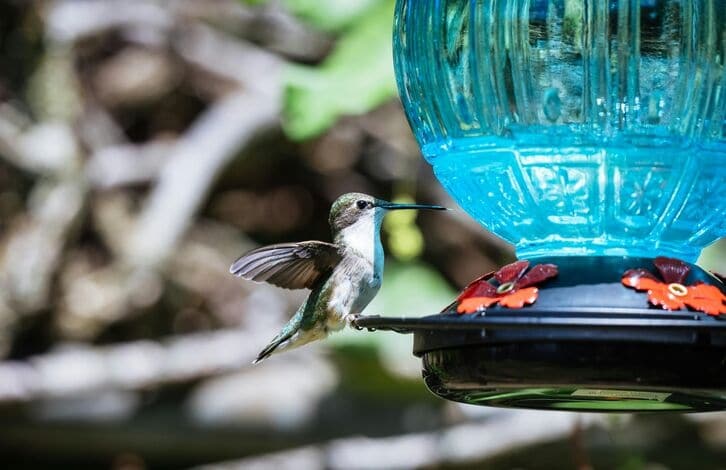
They have red accents and tiny feeding ports to keep sugar water or nectar. These window-mounted versions bring hummingbirds incredibly close and often feature inbuilt bee guards and easy-clean designs.
Multi-Port Platform Feeders
As the name suggests, these are flat, wide platforms with raised edges. They are built for variety and to handle the bird traffic. These feeders have multiple compartments so that you can attract more bird species.
Benefits of a Window Feeder
Window-mounted bird feeders come with several benefits, as listed below. These advantages are what make these feeders superior to traditional yard feeders.
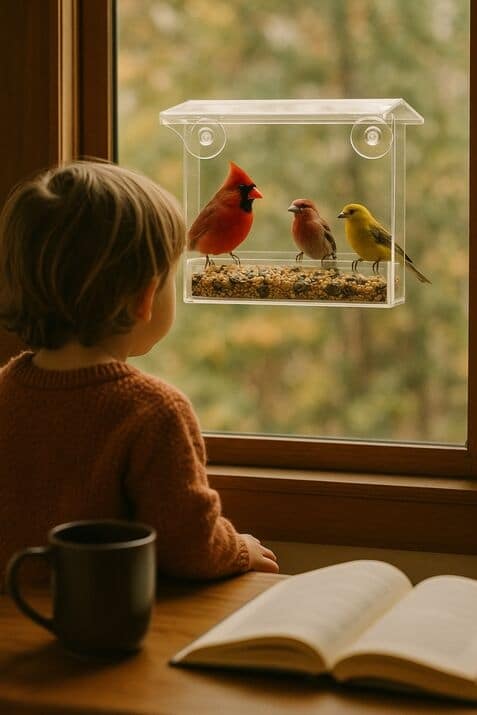
Close-Up Bird Observation
Now, forget the 10-20 feet distance you get with regular feeders! Window feeders bring birds inches from your face. You can see every tiny feather and peck and how they feed and interact.
Mental Health & Wellness Benefits
Watching birds is surprisingly calming. It lowers stress, helps with anxiety, and can even boost mood. Thus, you can get those feel-good vibes anytime with a bird feeder window, whether it’s your morning coffee or a mid-afternoon brain break. If you’re working from home or spending a lot of time indoors, a feeder paired with a fresh scent from the best air fresheners for home can enhance your space and overall well-being.
Educational Merits
Got kids? Or just love learning? These feeders turn your window into a living science class. You can spot different species, see how birds compete for food, and track seasonal migration patterns.
Space Saving
No yard? No problem! You won’t need any outdoor space with these feeders. You’ve got a bird-watching setup if you’ve got a window. It’s an ideal setup for apartment life or homes with a zero backyard.
Weather Independence
Rain? Snow? Cold? Doesn’t matter! You can stay warm and cosy indoors while watching birds do their thing. It’s a hassle-free bird watching without the weather drama.
Accessible
Since the feeder is at your window, cleaning and refilling it is simple. No trekking through the yard or wrestling with ladders. Just open the window, and you’re good to go!
Natural Pest Control
Birds don’t only eat seeds. They also snack on bugs, spiders, and other tiny pests around your home. So, you’re also getting natural pest control and live entertainment simultaneously.
Ideal for Bird Photography
Want Insta-worthy bird pics? The close range and perfect angle make a bird feeder window great for photography. You can snap detailed shots even with a smartphone without scaring the birds away.
(For those who love vibrant visuals around their feeders, incorporating vibrant pink flowers near windows can make the area even more beautiful.)
Selecting the Ideal Location
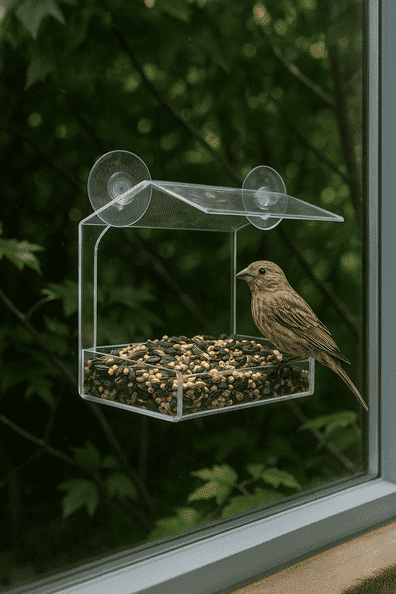
Where you place your window bird feeder can make or break the experience. Pick a spot that’s easy to see from inside your home. You want a clear view. Yet, safety also comes first. You must keep the feeder out of reach of curious cats or other predators.
You should also avoid spots where birds might fly straight into the glass. Here’s another pro tip: watch the sun! Too much heat can also spoil the food quickly. Birds love the shady spot as it keeps their snack fresh and cool.
Birds might love your feeder, but so do their predators. Please ensure the feeder is high enough off the ground to keep it out of reach of cats or other animals that might sneak up on them. Also, try to give birds a bit of overhead cover like a roof, awning, or nearby tree branches.
Birds like having nearby places to hide if they get spooked. Setting up your feeder near trees, shrubs, or bushes gives them a quick escape route and a place to rest. Try to avoid placing your feeder near a room that’s always busy or noisy. Constant movement or loud sounds from inside can scare birds off before they even give the feeder a try.
Installing a Bird Feeder Window
Here’s what you will need to install a window-mounted bird feeder:
- Window bird feeder with suction cups
- Glass cleaner or soap and water
- Clean towel or cloth
- Bird seed
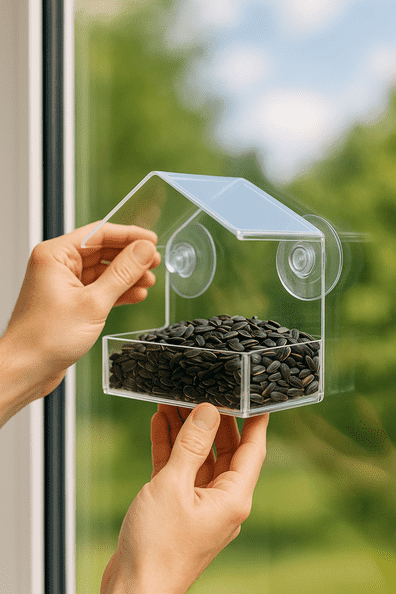
Step-by-Step Installation Guide
Step 1: Select the best place for a bird feeder
By the best place, we mean choosing the best window to install your bird feeder. Avoid placing the feeder too close to trees or bushes where predators might hide. We’d recommend you choose a spot that’s quiet and away from heavy foot traffic.
Step 2: Clean the window
Use soap and water to clean the window thoroughly. Now, dry it completely with a clean towel. The suction cups won’t stick properly if dirt or grease is stuck on the glass.
Step 3: Prepare the suction cups
Soak the cups in hot or warm water for 5-10 minutes. Allow them to take their standard shape if bent from the packaging. Ensure they’re clean too!
Step 4: Attach the feeder
Now, dampen the suction cups lightly in water for a better stick. Then, press each suction cup firmly against the clean window. Just like that, your bird feeder window is ready to welcome feathered visitors. Lastly, ensure the feeder sits at a level and feels secure.
Step 5: Add bird seeds
Fill the tray with bird seeds. Add black oil sunflower seeds (most birds love these) or a mixed bird seed blend. Leave some room so seeds don’t spill out. Now, BE PATIENT! Birds may take a few days or weeks to discover your new feeder. You will have regular visitors once it’s found.
For a visual guide, check out this video tutorial on assembling a window bird feeder.
If you use a feeder type other than the suction cups, follow the following installation steps.
Tube Feeders (Window-Mounted)
- Attach the mounting bracket to your window using suction cups.
- Ensure the bracket is level and secure.
- Hang the tube feeder on the bracket hook.
- Fill through the top opening with appropriate seeds (sunflower, mixed seeds, nyjer)
- Replace the cap/lid securely.
Suet Feeders
- Attach using removable suction cups.
- Press suction cups against the clean window.
- Open the wire cage front.
- Insert suet cake into the cage.
- Close and secure the cage door.
- Position where woodpeckers can easily access.
Hopper-Style Window Feeders
- Use strong suction cups (these feeders are heavier when full)
- Mount the base securely to the window for a sturdy bird feeder window setup.
- Fill the hopper compartment with mixed bird seeds.
- Ensure the feeding tray is positioned correctly.
- Check that the seed can flow freely to the tray.
Nectar/Hummingbird Feeders
- Clean and dry the window before installation. While cleaning with a vacuum, ensure the vacuum pads are dunked in hot water.
- Attach suction cups to the window.
- Prepare nectar (4 parts water to 1 part sugar)
- Turn it upside down and fill it while removing the base, or remove the ant moat at the top if equipped.
- Hang the filled feeder on the window mount.
- Position away from direct sunlight to prevent nectar spoilage.
Multi-Port Platform Feeders
- Use extra-strong suction cups due to size and weight.
- Mount the platform level against the window.
- Use the removable divider to offer two different types of food.
- Fill different sections with various seeds, nuts, or suet bits.
- Ensure drainage holes aren’t blocked.
Which native birds will visit the bird feeder window?
The specific native species will vary based on your geographic location. You should also explore your region a bit to see what you might be able to attract to your feeder.
The most frequent window feeder visitors include small songbirds like black-capped chickadees, American Goldfinches, house finches, and white-breasted nuthatches. Northern Cardinals are attracted to sunflower seeds and mixed seeds.
Regarding woodpeckers, the downy woodpeckers visit suet feeders and sunflower seeds. And, regarding speciality feeders, the Ruby-throated hummingbirds (Eastern US) are nectar feeders only. The dark-eyed Juncos are ground feeders that visit the platform feeders.
If you’re a plant lover too, you may want to check out native, pollinator-friendly options like the Vermillionaire plant—which hummingbirds love just as much as nectar feeders.
How do you clean and maintain a bird feeder window?
Is there a buildup of bird droppings or seed hulls on or around your window bird feeder? If yes, it’s high time to clean it! So, you can watch a few signs before you know it’s time to clean your feeder.
The first one is the buildup we’ve already mentioned. Next, you can look at the cloudy texture of sugar water. You should also consider cleaning on a frequent basis, especially in warmer temperatures, heavy wet spells, or if there’s an outbreak like salmonella in your area.
They should be cleaned every one or two weeks. Hummingbird feeders need more frequent cleaning every 2 to 5 days.
Steps to clean a seed feeder
Step 1: Discard
Take your feeder apart, i.e. uninstall and discard any debris or leftover food.
Step 2: Prepare cleaning mix
Mix the water and dish soap liquid to clean in a plastic bowl.
Step 3: Scrub
Use a bristle brush to thoroughly scrub every feeder section, including inside and outside.
Step 4: Dry
Once cleaned thoroughly, rinse it with water and dry it completely before filling it with fresh seeds.
Note: You can also use a mixture of nine parts of water and one part of bleach for deeper cleaning.
Steps to clean a hummingbird feeder
Step 1: Discard
Uninstall and remove all the remaining nectar.
Step 2: Clean
After removing the leftover nectar, rinse it off with water. Then, prepare a cleaning mix with one part white distilled vinegar and two parts water.
Step 3: Soak
Soak it in the cleaning mix for a few minutes and grab a brush to remove any hard debris. Then, rinse it thoroughly with water. Allow it to dry fully, and refill it with fresh nectar.
For more detailed cleaning tips, refer to this guide on keeping your bird feeder safe and clean.
Are bird feeder windows safe?
Window feeders can be SAFER than regular feeders when positioned correctly. Yet, you can still take a few precautionary steps to prevent birds from further harm.
Place bird feeding stations within three feet (1 meter) of the window or beyond ten feet (3 meters). If you’re worried about window strikes, we recommend moving your favourite bird feeders closer to windows.
By selecting a window feeder or changing the feeder location so it’s nearer to a window, you will take the first step in window strike prevention.
Additional safety tips
- Close curtains and blinds to break up the illusion of clear passage or reflected habitat.
- Applying decals, films, cords, or markers to the outside of windows can break up reflections.
- Keep the feeder consistently stocked so birds know to expect it there.
Conclusion
There, you have everything you need to turn a plain window into a front-row seat to nature. From picking the correct type of feeder to keeping it safe and clean, you’re now ready to welcome your feathered neighbours up close with your new bird feeder window.
Whether you’re hoping for finches, cardinals, or chickadees, one thing’s for sure: your mornings are about to get much more interesting. So pick your feeder, stick it up, and start enjoying the view. The birds are waiting.
(For a full home transformation, pair your bird-friendly windows with soothing greenery from our indoor flowers and plants guide.)
FAQs
Where is the best place for a bird feeder on my window?
You can keep it within 3 feet of the window or beyond 10 feet. You can move the feeder close to the window, especially if many bird window strikes are in your area. Ensure that you keep the feeder at eye level for a clear view.
How long does it take for birds to find a new bird feeder window?
It generally takes 3-14 days for the birds to find new food sources and feel safe approaching your window. Consistency in keeping it filled helps.
Can I put a window-mounted bird feeder on a second-floor window?
Yes, the second floor also works well for feeders. Many birds are comfortable feeding at various heights. Just ensure easy access for cleaning and refilling.
What makes the best window bird feeder?
Key considerations include simple installation, strong suction cups, a clear viewing area, easy cleaning design, and weather resistance.
Why won’t birds come to my bird feeder window?
If it’s a new feeder, it needs time for discovery. So, give it 1-2 weeks, and ensure you’re using the appropriate seeds.
How do I stop my window bird feeder suction cups from falling?
Clean the window thoroughly, ensure suction cups are clean and in good shape, press firmly to remove air bubbles, and consider the weight capacity of your specific feeder model.

